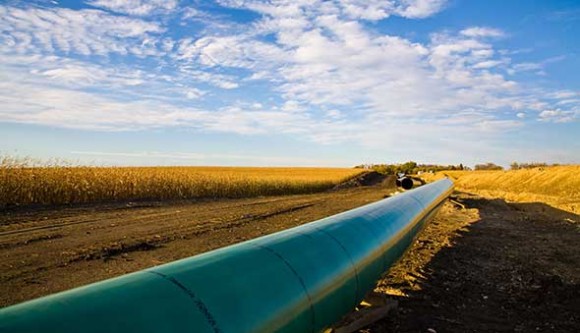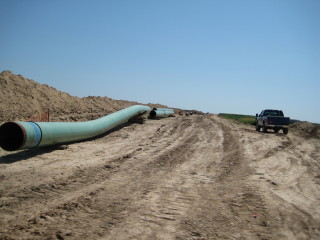
From Ukraine peace plans to Kazakh uranium—all that and more in our new nuclear digest
Our November Nuclear Digest by Bellona’s Environmental Transparency Center is out now. Here’s a quick taste of just three nuclear issues arising in U...
News

Publish date: February 4, 2015
News
NEW ORLEANS – Documents released this week by the US Environmental Protection Agency say moving forward with the completion of the Keystone XL pipeline would cause “significant increase in greenhouse gas emissions,” giving President Obama a crucial roadmap for shutting the project down.
The EPA is one of eight federal agencies that were due Monday to weigh in with views on Keystone XL to inform the State Department’s ongoing analysis of whether the proposed border-crossing pipeline is in the US’s national interest.
The 1,897 km pipeline would run from Hardesty in Alberta, Canada through several US states to Nederland, Texas on the Louisiana border.

The EPA comments challenged the State Department findings of last year that said the pipeline project would have “little impact on climate change.”
In its letter, the EPA focused on the State’s assertion that the Alberta Tar Sands would be developed whether the US portion of the Keystone pipeline were built or not, as oil companies would just transport the climate-volatile tar sans oil out of Canada by rail instead.
The EPA letter targets not only tar sands disastrous climate effects, but also urges the Obama administration to consider the recent crash in oil prices as it continues its environmental review on granting the pipeline a permit.
Falling oil prices to drive up carbon emissions
The EPA said the State Department’s environmental review of Keystone should give “additional weight” to whether the sharp drop in oil prices would increase the pipeline’s environmental impact and stimulate production in the carbon-rich Canadian oil sands.
The State Department analysis found that the only way the pipeline construction could be made profitable was if oil prices stayed between $65 and $75 per barrel. But the EPA noted crude was now trading at about $50 per barrel. This, said the EPA, would “result in increased oil sands production, and the accompanying greenhouse gas emissions, over what would otherwise occur” were pipeline construction to go ahead.

“Tar sands have a huge CO2 footprint and a rather poor energy ratio when all the processing is taken into account,” said Keith Whiriskey, policy manager for climate technologies at Bellona Europa in Brussels. “They need to pretty much wash the oil of the sand with boiling water and that takes a lot of energy, plus all the mining and all the upgrading, making the use of tar sands very CO2 intensive.”
Whiriskey supported the EPA analysis that depressed oil prices would make CO2 emissions worse.
“The marginal price of oil produced from the tar sands is about $60, so that means that at $45 they are out of the money,” he said. “What this means the future of oil sands is dependent on how long the price remains low, but it already looks like investment there is slowing rapidly.”
He said that Shell, which is the driving force behind Canada’s tar sands recovery, has announced some lay-offs.
How ‘significant’ are tar sands climate impacts?
The EPA’s assertion that the pipeline’s climate impact would be “significant” is perhaps most important watchword in the agency comments for environmental groups that oppose the pipeline.
“Until ongoing efforts to reduce greenhouse gas emissions associated with the production of oil sands are more successful and widespread,” the EPA wrote, the environmental review of the project shows that “development of oil sands crude represents a significant increase in greenhouse gas emissions” when compared to the development of reference crudes.
The letter gave specifics on just how significant the spikes in developing tar sands crudes would be: 1.3 to 27.4 million metric tons of carbon dioxide equivalent per year, which equals the pollution from almost 6 million passenger vehicles or eight coal-fired power plants.
These are crucial comments from the EPA, as they mirror statements delivered by Obama in late June in which he said, “our national interest will be served only if this project does not significantly exacerbate the problem of carbon pollution.”

“The net effects of the pipeline’s impact on our climate will be absolutely critical to determining whether this project is allowed to go forward,” Obama continued. “It’s relevant.”
Would CCS make a dent in tar sands emissions?
The only thing that would have any impact on these heavy emissions, argued Bellona’s Whiriskey, is a CCS project Shell is trying to spearhead in Alberta. But he has doubts that the company can sustain the operation in the face of wobbly oil prices.
Called Shell Quest, the program aims to store more than 1 million tons of captured CO2 underground in a saline aquifer.
“Oil sands are bad,– they eat into the carbon budget and they will need a lot of CCS just to make their emissions equivalent to ‘easy oil,’” said Whiriskey. He added that Shell Quest is a favorable option as “it’s all about storing the CO2, which is good, as Alberta can only decarbonize effectively by using CCS because of its heavy industries and extractive industries.”
But Whiriskey noted there’s a sticking point: “Can tar sands afford CCS when they are already the margin barrel on the market?”
Will a veto kill the pipeline?
Obama is meanwhile set to veto the Keystone bill, which is scheduled to reach his desk on February 16 – on the grounds that administration wishes to continue its environmental review.
But Obama has still not indicated whether he’ll ultimately bin the project after six years of study. Environmentalists here in the US, however, say the EPA commentary has provided the President with sufficient doubt to deny the pipeline project a permit.
“The President has all the nails he needs to finally close the lid on this particular boondoggle,” Bill McKibben, co-founder of the green group 350.org, and America’s most visible opponent of the Keystone XL project, told a conference call with reporters. He called the EPA’s letter a “damning report.”
The State Department also asked the Pentagon and the Departments of Energy, Justice, Interior, Commerce, Transportation and Homeland Security to weigh in on its national interest determination before Secretary of State John Kerry makes his final recommendation to the President; their comments were due on February 2.

Our November Nuclear Digest by Bellona’s Environmental Transparency Center is out now. Here’s a quick taste of just three nuclear issues arising in U...

For three years now, Bellona has continued its work in exile from Vilnius, sustaining and expanding its analysis despite war, repression, and the collapse of international cooperation with Russia in the environmental and nuclear fields

The Board of the Bellona Foundation has appointed former Minister of Climate and the Environment Sveinung Rotevatn as Managing Director of Bellona No...

Økokrim, Norway’s authority for investigating and prosecuting economic and environmental crime, has imposed a record fine on Equinor following a comp...